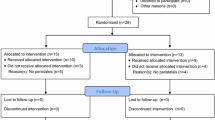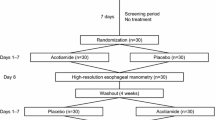Summary
In a placebo-controlled, double-blind study the effects of depressing duodenal motility by administration of intravenous trospium chloride during gastro-duodenoscopy were studied in 72 patients randomised to receive trospium chloride or saline (controls). Intravenous trospium chloride 1.2mg stopped the visible contractile activity of the duodenum as assessed by 3 independent observers during videoendoscopy within 76 seconds (median). During a 4-minute observation period of duodenal peristalsis, duodenal motor activity was found to stop in 18 of 36 patients after trospium chloride but in only 5 of 36 patients in the placebo group (p = 0.002). Adverse effects were dry mouth, micturition difficulties, sweat retention, accommodation disturbance and tachycardia. Trospium chloride was effective in reducing contractile activity in the duodenum. Its potent action and minor adverse effect profile appear to be promising for gastroduodenoscopy and especially for sphincter of Oddi motility in patients during routine endoscopic retrograde cholangiopancreatography.
Similar content being viewed by others
References
Frieling T, Enck P, Dohmann R, et al. The effect of trospium chloride on oesophageal motility. Aliment Pharmacol Ther 1993; 7: 75–80
Pfeiffer A, Schmidt T, Höller T, et al. Effect of trospium chloride on gastrointestinal motility in humans. Eur J Clin Pharmacol 1993; 44: 219–23
Schmidt T, Widmer R, Pfeiffer A, et al. Effect of the quaternary ammonium compound trospium chloride on 24 hour jejunal motility in healthy subjects. Gut 1994; 35: 27–33
Madersbacher H, Stöhrer M, Richter R, et al. Trospium chloride versus oxybutynine: a randomised, double-blind, multicentre trial in the treatment of detrusor hyperreflexia. Br J Urol 1995; 75: 452–6
Brown JH, Taylor P. Muscarinic receptor agonists and antagonists. In: Hardman JG, Limbird LE, Molinoff PB, et al., editors. Goodman & Gilmans: The pharmacological basis of therapeutics. 9th ed. New York: McGraw-Hill, 1996: 141–60
Myamoto D. The action of cholinergic nerves on motor nerve terminates. Pharmacol Rev 1977; 29: 225–47
Pietzko A, Dimpfel W, Schwantes U, et al. Influences of trospium chloride and oxybutynin on quantitative EEG in healthy volunteers. Eur J Clin Pharmacol 1994; 47: 337–43
Salentin M, Malchow H, Mühlhofer H, et al. A randomised controlled trial to evaluate the effects of flumazenil after midazolam premedication in outpatients undergoing colonoscopy. Endoscopy 1991; 23: 331–3
Staritz M. Pharmacology of the sphincter of Oddi. Endoscopy 1988; 20: 171–4
Matzkies F, Miirtz G, Gianetti B, et al. Ultrasound studies of the effect of trospium chloride on gall-bladder kinetics. Drug Res 1992; 12: 1456–8
Norfleet RG. Premedication for colonoscopy: randomized, double blind study of glucagon versus placebo. Gastrointest Endosc 1978; 24: 164–5
Bond JH, Chally CH, Blackwood WD. A controlled trial of premedication with dicyclomine hydrochloride (Bentyl® in colonoscopy. Gastrointest Endosc 1974; 21: 61
Saunders BP, Williams CB. Premedication with intravenous antispasmodic speeds colonoscope insertion. Gastrointest Endosc 1996; 43(3): 209–11
Saunders BP, Elsby B, Boswell AM, et al. Intravenous antispasmodic and patient-controlled analgesia are of benefit for screening flexible sigmoidoscopy. Gastrointest Endosc 1995; 42(2): 123–7
Waxman I, Methews J, Gallagher J, et al. Limited benefit of atropine as premedication for colonoscopy. Gastrointest Endosc 1991; 37: 329–31
Cutler CS, Rex DK, Hawes RH, et al. Does routine intravenous glucagon administration facilitate colonoscopy? A randomised trial. Gastrointest Endosc 1995; 42(4): 346–50
Author information
Authors and Affiliations
Rights and permissions
About this article
Cite this article
Rohde, H., Bihr, A.M., Schwantes, U. et al. Effect of Trospium Chloride on Duodenal Motility during Upper Gastrointestinal Endoscopy. Clin. Drug Invest. 13, 85–89 (1997). https://doi.org/10.2165/00044011-199713020-00004
Published:
Issue Date:
DOI: https://doi.org/10.2165/00044011-199713020-00004




